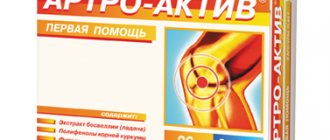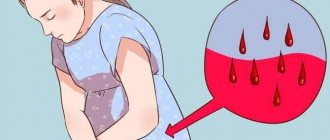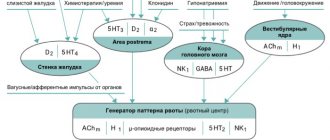Arava®
With hepatotoxic drugs and substances (including ethanol) or hematotoxic and immunosuppressive drugs
Increased adverse effects may occur when recent or concomitant use of hepatotoxic drugs and substances (including ethanol) or hematotoxic and immunosuppressive drugs is used, or when these drugs are started after treatment with leflunomide without a “Special Instructions” procedure.
With methotrexate
In some (5 out of 30) patients with rheumatoid arthritis, while taking leflunomide (10 - 20 mg per day) and methotrexate (10 - 25 mg per week), a 2-3-fold increase in the activity of liver enzymes in the blood was observed, and in the other 5 patients there was a more than 3-fold increase in the activity of “liver” enzymes in the blood. In all cases, these phenomena disappeared: in 2 patients while continuing to take both drugs, and in 3 patients after stopping taking leflunomide. Therefore, although there is generally no need for a waiting period when switching from leflunomide to methotrexate, careful monitoring of liver enzymes in the blood is recommended during the initial treatment phase after switching a patient from leflunomide to methotrexate.
Vaccination
There are no clinical data regarding the effectiveness and safety of vaccination administered during treatment with leflunomide. However, vaccination with live vaccines is not recommended. When planning vaccination with a live vaccine after discontinuation of leflunomide, its long half-life should be taken into account.
With warfarin
Cases of increased prothrombin time have been reported when taking leflunomide and warfarin simultaneously. In a clinical pharmacological study, a pharmacodynamic interaction between warfarin and A771726 was observed (see below). Therefore, when using warfarin and leflunomide simultaneously, careful monitoring of the INR (international normalized ratio) is recommended.
With food
The degree of absorption of leflunomide is not affected when it is taken together with food.
Effect of other drugs on leflunomide
In
vitro
studies conducted on human liver microsomes confirmed that the cytochrome P450 isoenzymes CYP1A2, CYP2C19 and CYP3A4 are involved in the metabolism of leflunomide.
in vivo
interaction study of leflunomide with cimetidine (a nonspecific weak inhibitor of cytochrome P450 isoenzymes) showed no significant effect of cimetidine on the systemic exposure of A771726. Following administration of a single dose of leflunomide to volunteers receiving multiple doses of rifampicin (a nonspecific cytochrome P450 inducer), maximum blood concentrations of A771726 increased by approximately 40%, whereas the area under the concentration-time curve (AUC) did not change significantly. The mechanism of this effect is not clear. The possibility of continued increases in leflunomide blood concentrations should be kept in mind in patients receiving multiple doses of leflunomide and rifampicin concomitantly. The use of cholestyramine or activated carbon leads to a rapid and significant decrease in the concentration of A771726 (the active metabolite of leflunomide) in the blood plasma. This is due to a violation of the enterohepatic recirculation of A771726 and/or its dialysis in the gastrointestinal tract (see sections “Pregnancy and breastfeeding” and section “Overdose”).
Effect of leflunomide on other drugs
Breast cancer resistance transport protein
( BCRP )
Although a pharmacokinetic interaction of A771726 with BCRP substrates (rosuvastatin) was observed (see below), no pharmacokinetic interaction was observed between leflunomide (10-20 mg daily) and methotrexate (a BCRP substrate; in 12 patients; 10 - 25 mg per week).
Drug interaction studies have demonstrated that there is no significant drug interaction between leflunomide and triphasic oral contraceptives. In a study in which leflunomide was administered to healthy female volunteers in conjunction with triphasic oral contraceptives containing 30 mcg ethinyl estradiol, no decrease in the contraceptive effect of the tablets was observed, and the pharmacokinetics of A771726 were well within their normal range. A pharmacokinetic interaction between contraceptives and A771726 has been observed (see below).
The following pharmacokinetic and pharmacodynamic interaction studies were conducted with A771726 (the main active metabolite of leflunomide). Since such drug interactions cannot be excluded for leflunomide when used at recommended doses, the following study results and recommendations should be taken into account in patients receiving leflunomide treatment.
Effect on repaglinide (
CYP 2 C
) After repeated doses of A771726, an increase in the mean maximum plasma concentration (Cmax) and AUC of repaglinide was observed (1.7 and 2.4 times, respectively), confirming that A771726 is an inhibitor of the CYP2C8 isoenzyme in
vivo .
Therefore, monitoring of patients concomitantly taking drugs metabolized by the CYP2C8 isoenzyme, such as repaglinide, paclitaxel, pioglitazone or rosiglitazone, is recommended, as this may increase their systemic exposure.
Effect on Caffeine (CYP1A2 Substrate
) Repeated doses
AUC of caffeine (CYP1A2 substrate) by 18% and 55%, respectively, suggesting that A771726 may be a weak inducer of CYP1A2 in
vivo .
Therefore, when combined with drugs metabolized by the CYP1A2 isoenzyme, such as duloxetine, alosetron, theophylline and tizanidine, caution should be exercised, as this may lead to a decrease in the effectiveness of these drugs.
Effect of organic anion transporter 3 (OAT3) on substrates
After repeated doses of A771726, an increase in the mean Cmax and AUC values of cefaclor was observed (1.43-fold and 1.54-fold, respectively), confirming that A771726 is an OAT3 inhibitor in
vivo .
Therefore, caution is recommended during concomitant use of OAT3 substrates, such as cefaclor, benzylpenicillin, ciprofloxacin, indomethacin, ketoprofen, furosemide, cimetidine, methotrexate, zidovudine.
Effect on
BCRP and/or organic anion transporting polypeptides B1 and B3 (OATP1B1/B3)
After repeated doses of A771726, an increase in the average Cmax and AUC values of rosuvastatin was observed (2.65 and 2.51 times, respectively). However, no significant effect of this increase in plasma exposure of rosuvastatin on HMG-CoA reductase activity was observed. When used concomitantly, the dose of rosuvastatin should not exceed 10 mg once daily. For other BCRP substrates (e.g., methotrexate, topotecan, sulfasalazine, daunorubicin, doxorubicin) and the organic anion transporter protein (OATP) family of substrates, especially HMG-CoA reductase inhibitors (e.g., simvastatin, atorvastatin, pravastatin, methotorexate, nateglinide, repaglinide, rifampicin) caution should also be exercised when using them together. Patients should be closely monitored for signs and symptoms indicating increased systemic exposure to these drugs, and a dose reduction of these drugs should be considered in such patients.
Effect on oral contraceptives (containing 0.03 mg ethinyl estradiol and 0.15 mg levonorgestrel)
After repeated doses of A771726, an increase in the mean values of Cmax AUC0.24 of ethinyl estradiol (1.58 and 1.54 times, respectively) and Cmax and AUC0-24 of levonorgestrel (1.33 and 1.41 times, respectively) was observed. However, this interaction is not expected to have an adverse effect on the effectiveness of oral contraceptives, and consideration of the type of oral contraceptive used is recommended.
Effect on warfarin
Repeated doses of A771726 have no effect on the pharmacokinetics of S-warfarin, indicating that A771726 is not an inhibitor or inducer of the CYP2C9 isoenzyme. However, with simultaneous use of A771726 and warfarin, a 25% decrease in maximum INR values was observed compared with those with warfarin alone. Therefore, when used concomitantly with warfarin, the INR should be carefully monitored.
Other interactions
If the patient is already taking non-steroidal anti-inflammatory drugs (NSAIDs and/or glucocorticosteroids), they can be continued after starting treatment with leflunomide.
There is currently no information regarding the combined use of leflunomide with antimalarial drugs used in rheumatology (for example, chloroquine and hydroxychloroquine), gold preparations (IM or orally), penicillamine, azathioprine and other immunosuppressants (with the exception of methotrexate, see above) . The risk associated with complex therapy, especially with long-term treatment, is unknown. Because this type of therapy can lead to the development of additive or even synergistic toxicities (for example, hepatotoxicity or blood toxicity), combinations of this drug with other basic drugs (for example, methotrexate) are undesirable. Recent concomitant or subsequent use of potentially myelotoxic agents may be associated with a greater risk of developing blood disorders.
Arava
The climate, flora and fauna of this desert are a mix of Africa and Asia.
Geographical location and geological features
The main feature of the Arava Desert is its location in the Jordan Basin. On the northern side, the desert borders on the Dead Sea, and on the southern side on the Red Sea. From the east it is approached by the Edom Mountains of Jordan, and from the west by the Negev Highlands.
The Arava area is not as large as the Negev Desert - its territory occupies 6% of Israel's territory. This desert is notable for its soil, which is a mixture of chalk and clay - it is called marl. Previously, there was a sea on the site of the Arava Desert, but the ongoing geological processes formed an interesting natural area. The sandstones and limestones have become hills, and there are both salty and freshwater layers underground.
Climatic conditions
The climate of the Arava Desert is very dry, sandstorms often occur here, and the heat in the summer is unbearable. There is little rain in the desert - no more than 50 mm per year. And even on January nights the temperature does not drop below minus 5 degrees.
If we talk about flora and fauna, then this is something between Africa and Asia; from the animal world you can find mainly representatives of the Sahara Desert. Occasionally you come across oases, and a large number of umbrella acacias make the Arava look like an African savannah.
Sights and tourist routes
The main attraction of the Arava Desert is the Timna National Park, where excursions are organized every day. It is here that the so-called “Eilat stone” is mined; tourists can admire rock paintings, explore ancient temples and copper mines.
The Hai Bar Nature Reserve is very interesting - snakes, predators and birds described in the Torah live here.
You can't miss visiting the city of Eilat. This is a comfortable resort on the Red Sea.
Another attraction and tourist route is Ein Hatzeva. Here archaeologists discovered the ruins of the city of Tamar, built in the 10th century BC. King Solomon.
Judean Desert
This desert has the most natural vegetation and animal species that live in the wild.
Geographical location and geological features
In terms of size, the Judean Desert, abutting the western part of the Dead Sea, is quite miniature - only 22 square meters. kilometers, and part of its territory is located in Jordan. There is a vast difference in altitude - from minus 50 to 900 meters above sea level.
The desert is a plain with numerous mountains, hills and canyons. During the rainy season, many waterfalls form in the crevices. In the western part of the Judean Desert, the soil consists mainly of limestone.
Climatic conditions
The Judean Desert is a subtropical zone, less hot here than in the Negev and Arava deserts. Precipitation falls here more often, which makes it possible to classify the Judean Desert as a rain shadow zone.
Flora and fauna are extensive for a desert. For example, here you can find black peten (poisonous snake), mountain goats, chamois, hyraxes and leopards. In the Judean Desert there are many carob and pistachio trees, as well as hawthorn.
Sights and tourist routes
The main attraction of the Judean Desert is the Masada fortress, which has become a symbol of the heroism of the Jewish people. You can take a one-day excursion here and explore in detail this fortress, built by Herod I the Great. A mosaic, the palace of King Herod and a synagogue have been preserved here.
You should definitely go on an excursion to Mount Muntar, from where in ancient times victims were thrown down - the “goats of atonement”.
Another tourist route includes a visit to the Qumran National Reserve and a tour of the ancient settlements of Khirbat Qumran.


